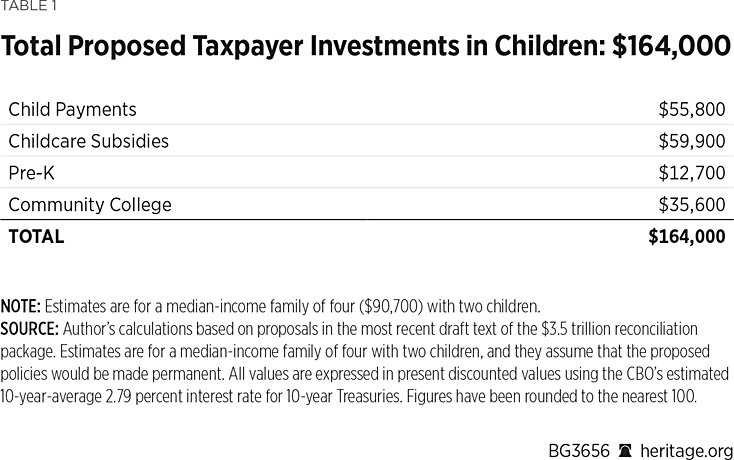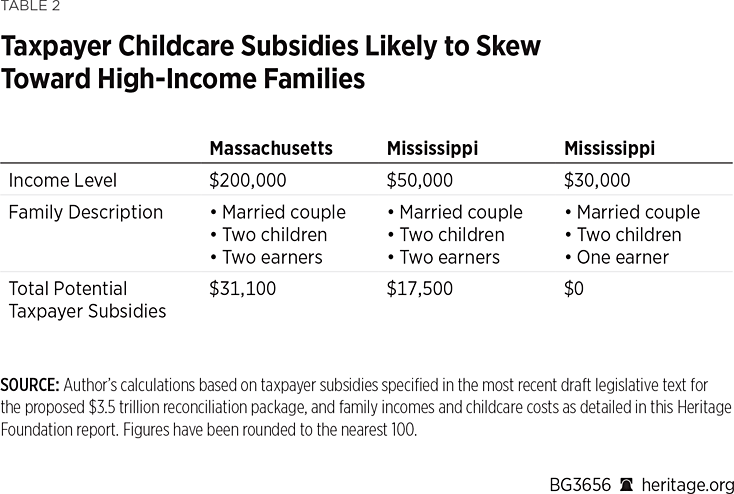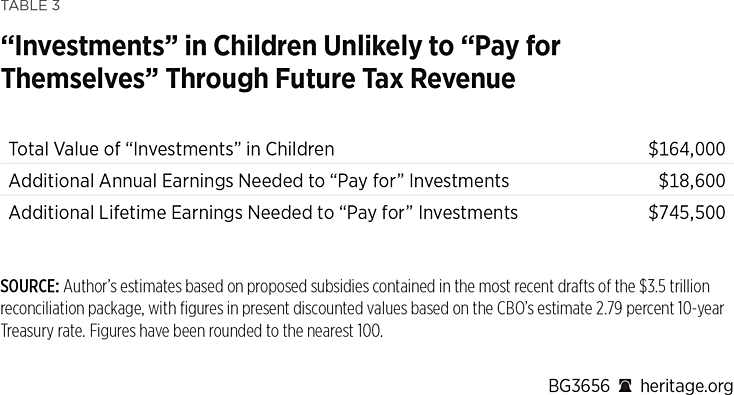Massive new spending and entitlement programs aimed at children and families are a key part of President Joe Biden’s agenda and congressional Democrats’ $3.5 trillion spending package. Supporters of monthly child payments, widespread childcare subsidies, universal Pre-K, and “free” community college claim that such programs will be investments, yielding positive returns. Senator Elizabeth Warren (D–MA) cited early childhood programs as producing between $4.00 and $9.00 dollars in returns for every $1.00 of spending, stating that, “In other words, these programs pay for themselves by the time children become adults. This is not just a nice thing to do. It is a smart investment that will yield positive returns for our country’s future.”REF At best, this assertion is unsupported speculation; at worst, it is negligent and will cause widespread harm.
While it is possible for spending focused on particularly at-risk or disadvantaged children to yield high returns, there is zero evidence that spending up to $164,000 on every middle-income child in America would provide positive returns.REF In order for such massive taxpayer spending to be worthwhile, every child who is a recipient of those taxpayer dollars would have to earn an extra $18,600 per year over a 40-year career, meaning an additional $746,000 over a lifetime.
In fact, at least one of these programs—taxpayer subsidies for government-directed childcare—could yield negative impacts on children and families. While it is almost impossible that these massive, near-universal taxpayer subsidies will pay for themselves, it is certain that they will result in significantly higher tax burdens, and they could harm the children and families they aim to help.
Putting a Price Tag on Children
The best way to help families is by providing opportunities for them to flourish as they seek to raise and provide for their children. Since every family has unique circumstances and ideals, family supports should not come through one-size-fits-all government programs, but rather through policies that keep their taxes low so that more of what parents earn can go toward providing for their children; by minimizing regulations that unnecessarily restrict families’ opportunities; and by giving parents choices for their children’s education.REF
Progressives instead want to raise taxes in ways that will reduce workers’ incomes, and then redistribute those taxes to provide $3,600-per-year worth of monthly payments for children ages five and under, and $3,000-per-year worth of payments for children ages six through 17. These payments would be distributed to parents in monthly amounts of $300 and $250 per child, regardless of whether parents work.REF Since work is the only long-term path out of poverty, removing work requirements would revert to the failed welfare policies that increased single-parent households and exacerbated the cycles of poverty prior to the bipartisan 1996 welfare reforms.REF Instead of focusing on families in need, these child payments create a new, nearly universal, entitlement with the smaller portion of the total payments ($1,000 or $1,600 per child per year) not phasing out until a married couple with two children earns between $190,000 and $214,000 per year, and the larger portion ($2,000 per child per year)REF not phasing out until a family with two children earns more than $480,000 per year.REF

If the child payments are made permanent,REF taxpayers are being asked to provide $55,800 worth of monthly payments for nearly every child in AmericaREF without a clear notion of how these payments will affect the well-being of children, parents, or society. Although payments are conditional on the presence of children in the home, there is no requirement that households use the payments to benefit children.REF
Economic studies show that additional income generally leads to improved child outcomes—but the effects are modest, sometimes negligible or even negative, for middle-income and upper-income households. An extra $3,000 per year is unlikely to lead to safer housing, an improved diet, or a better school for a child in a family that already has a six-figure income. Moreover, the fact that the government already spends $1.1 trillion on welfare benefits that aim to meet lower-income families’ food, housing, health care, and childcare needs means that additional child payments, which can act as a disincentive to work, will be of limited value.REF
Pushing Children into Government-Approved Childcare and Pre-K
Finding the childcare that parents want, at a cost they can afford, can be a struggle, especially for single parents and lower-income families.
The high cost of childcare is often cited as a primary problem, with the average price of center-based licensed childcare in the U.S. equal to $15,900 per year for infants, $13,200 per year for toddlers, and $10,700 per year for preschool-age children.REF
If the proposed childcare and Pre-K programs were made permanent,REF taxpayers would spend a total of $73,100 on childcareREF and Pre-KREF costs during the first five years of a child’s life.REF Taxpayer spending would vary significantly by state, with taxpayers financing up to $108,600 worth of childcare and Pre-K for children in a family with a median income of $125,000 in a high-cost state, such as Massachusetts, compared to $49,200 worth of childcare and Pre-K costs for a family with a median income of $66,600 in a low-cost state, such as Mississippi.
Such large subsidies would be available only to parents who send their children to government-approved childcare providers that would have to comply with a new set of government standards. Yet, only 14 percent of parents prefer to send their children to full-time, center-based childcare. The subsidies would not provide assistance to the 70 percent of parents who prefer parental or relative care.REF Parents who prefer center-based care tend to have higher incomes and higher levels of education while lower-income families and Hispanic families have the least preferences for center-based care.REF
Nevertheless, by making childcare low cost or no cost for many families, the proposed childcare subsidies would shift many children from family-based childcare to government-directed, center-based childcare and Pre-K.REF Advocates of subsidies for government-directed childcare argue that it provides large benefits to children and families and could even “pay for itself” through higher government tax revenues. Those claims are based on two boutique preschool programs that provided wrap-around services to the households of a few dozen highly at-risk African American children five decades ago.REF The Nobel Prize–winning author of economic studies on those programs, James Heckman, explained why such high returns are not applicable on a wide-scale basis:
I have never supported universal pre-school. The benefits of public preschool programs are the greatest for the most disadvantaged children. More advantaged children generally have encouraging early family lives. The “intervention” that a loving, resourceful family gives to its children has huge benefits that, unfortunately, have never been measured well. Public preschool programs can potentially compensate for the home environments of disadvantaged children. No public preschool program can provide the environments and the parental love and care of a functioning family and the lifetime benefits that ensue.REF (Emphasis in original.)
The proposed subsidies for full-time, center-based childcare would arguably subtract from the benefits of a “loving, resourceful family” by reducing parenting and increasing paid time in the labor force, particularly for mothers.REF With children’s home and family environments, the greatest determinant to their well-being and outcomes, shifting kids from family-based care and into center-based care is more likely to impose a burden on children than to serve as an investment in them.REF That has been the case in Quebec, where highly subsidized childcare led to children experiencing greater aggression, reduced motor and social skills, more hostile and less consistent parenting, lower-quality family relationships, and increased rates of crime and anxiety in children’s teenage years.REF
Universal government Pre-K programs, such as Head StartREF and Tennessee’s Voluntary Pre-KREF initiative, have also produced little, if any, lasting positive results, and have sometimes had adverse effects on children.REF Considering the weak evidence of positive impacts from large-scale government childcare and Pre-K programs, it is highly unlikely that the very costly proposed programs could pay for themselves, especially considering that the proposals would drastically drive up the costs of childcare.
Imposing new requirements on childcare providers—such as mandated wage requirements, encouraging the hiring of childcare workers with college and teaching degrees, and likely reducing child-to-staff ratios—and capping family payments is likely to cause childcare costs to explode, just as the price of cars would soar if the federal government were to give families taxpayer dollars to pick out any luxury vehicle they want while paying only a small, fixed fee.REF
Childcare Subsidies Skewed Toward Affluent Families
In contrast to existing means-tested welfare benefits and programs, the proposed investments in childcare would likely skew toward affluent families that have stronger preferences for center-based childcare, and that are more likely to live in high-cost areas.
The examples below show that taxpayers would spend $31,100 per year in childcare subsidies for a two-earner family with $200,000 of income that lives in Massachusetts with two young children. Taxpayers would spend $17,500 per year in childcare subsidies for a similar two-earner family with $50,000 of annual income that lives in Mississippi with two young children. Meanwhile, taxpayers would provide no childcare subsidies to that same Mississippi family if one parent were to stay home with the children. Considering the different preferences of families based on income and education level as discussed above, the childcare and Pre-K subsidies are likely to disproportionately benefit more affluent families.

“Free” Community College
President Biden’s and progressives in Congress want to provide two years’ worth of “free” community college to all young adults. Education can be a very profitable investment that leads to significantly higher future earnings, but it depends on the quality of the education; its relevance to students’ future work; and students’ aptitude, effort, and commitment to their studies.
Although the current cost to students of community college is low, around $3,000 per year, the actual cost is $17,900 per year per student after including existing taxpayer subsidies and other non-tuition revenues. Thus, the total cost to taxpayers of two years of community college would equal nearly $36,000 per student.REF In order to make such investments in young adults worthwhile, they would not only have to graduate from community college, but their earnings would have to be significantly higher in the future.
Community colleges have very poor track records for success, with only 28 percent of students who begin community college completing their two-year degrees within three years.REF In large part, these poor metrics reflect the fact that federal, state, and local taxpayers already heavily subsidize community colleges. More than 80 percent of community college enrollees currently receive financial aid, and many students pay nothing, and are even receiving money to cover their living expenses.REF
The problem with the “free tuition” proposal is that its provisions would almost certainly exacerbate lackluster outcomes and drive up community college costs. Without any “skin in the game,” students will have less incentive to succeed. As an extension to current K–12 public education, the addition of “free” community college would further weaken incentives in the K–12 public school system to produce college-ready students. Moreover, the proposal would incentivize states to increase their costs by replacing state and local governments’ current funding of community colleges with a federalized, flat-rate, cost-sharing fee regardless of whether a state implements cost-savings measures or significantly drives up their costs.
Is the Proposed Spending on Children and Families an Investment or a Liability?
In total, President Biden’s proposals would “invest” up to $164,000 (in today’s dollars) in every child in America.REF Some policymakers have suggested that such “investments” will “pay for themselves.” For that to be true—for the spending to yield a positive result—a child would have to earn an additional $18,600 per year (in today’s dollars), or $746,000 total over a 40-year working career in order for the additional taxes they pay to cover the cost of previous taxpayers’ “investments” in them.REF
In contrast, if the additional spending had no impact on children’s future earnings, other than to create an additional tax liability to pay off the past “investment” costs, a child would have to pay an additional $4,100 (in today’s dollars) of taxes every year over a 40-year career, meaning that a married-couple household would have $8,200 less in disposable income each year.
There are public investments that yield positive returns, but there is no credible evidence that the proposed investments—the largest amounts made on behalf of children in middle-income and upper-income households—will yield positive returns. Moreover, evidence from large-scale government childcare programs shows that policies that cause more children to be in environments that do not reflect their parents’ primary preferences can have significant and lasting negative consequences on children and families.
Conclusion
Progressive policymakers are poised to pass a massive $3.5 trillion spending package. Among that proposal’s many provisions are significant so-called investments in families that would—if made permanent—amount to spending up to $164,000 on every child in America. In order for such additional spending to be an investment, each of those children would have to earn an additional $18,600 during every year of a 40-year career, or $746,000 in total (in today’s dollars), to make current taxpayers’ “investments” in them worthwhile.REF The proposed subsidies would also disproportionately flow to middle-income and upper-income families.

Rather than create a multitude of one-size-fits-all unfunded entitlement programs, policymakers should focus on providing greater flexibility within the existing resources provided to families in need. For example, Congress should allow families to use existing childcare subsidies—including the roughly $10,000 per year spent on each child in Head Start—at a childcare provider of their choice.REF Moreover, lawmakers should pare down—instead of pile on—unhelpful childcare regulations that are currently restricting the supply of more flexible and affordable childcare options.
Finally, rather than raising taxes in ways that will lead to lower incomes and higher prices for everyone, and then redistributing those taxes based on what politicians believe is best for children and families, lawmakers should enact policies that increase income opportunities and that allow everyone to keep more of the money they earn to spend on what they decide is best for them.
Rachel Greszler is Research Fellow in Economics, Budget, and Entitlements in the Grover M. Hermann Center for the Federal Budget, of the Institute for Economic Freedom, at The Heritage Foundation.



